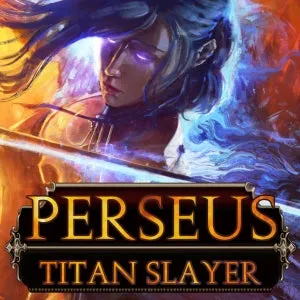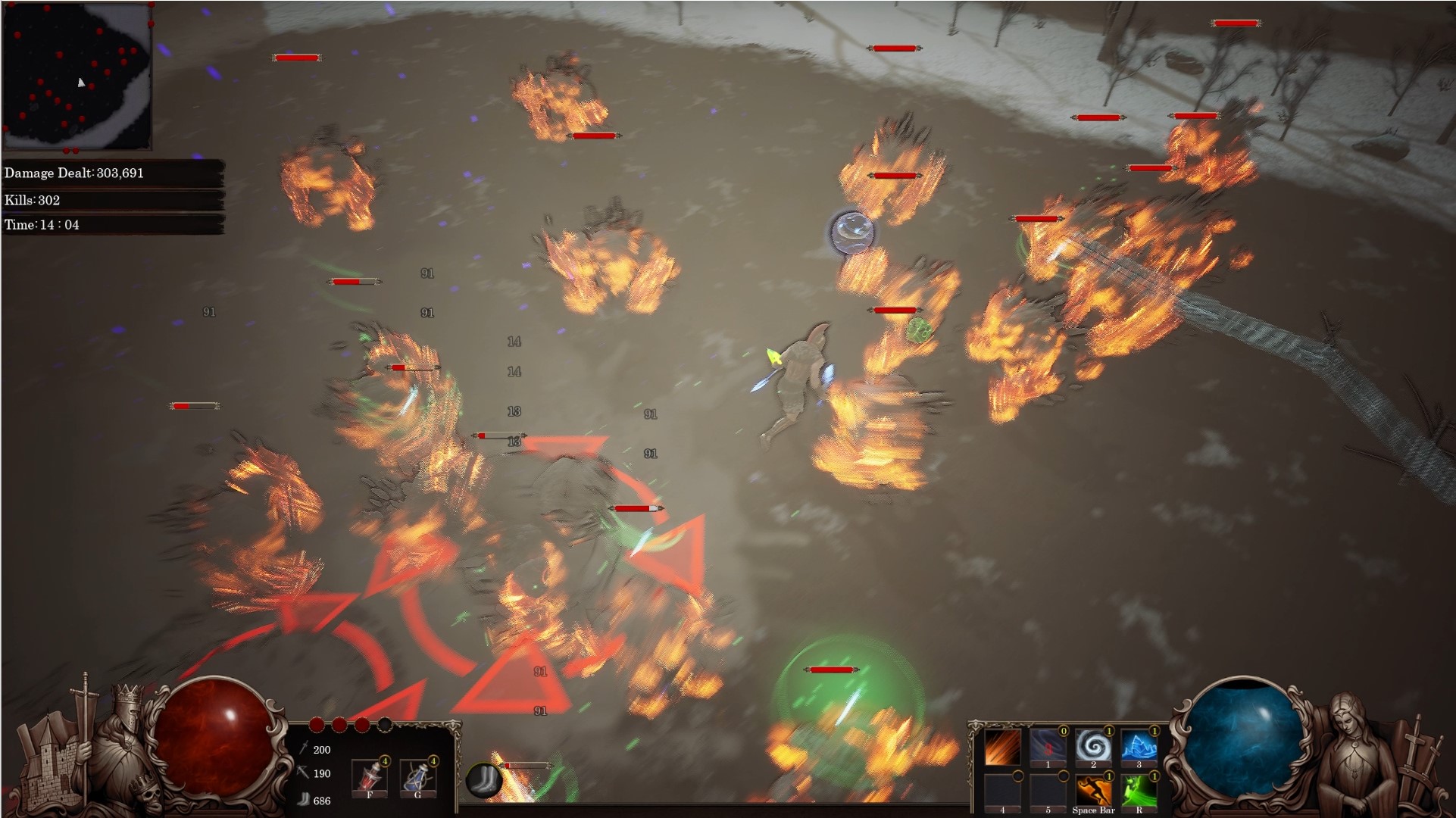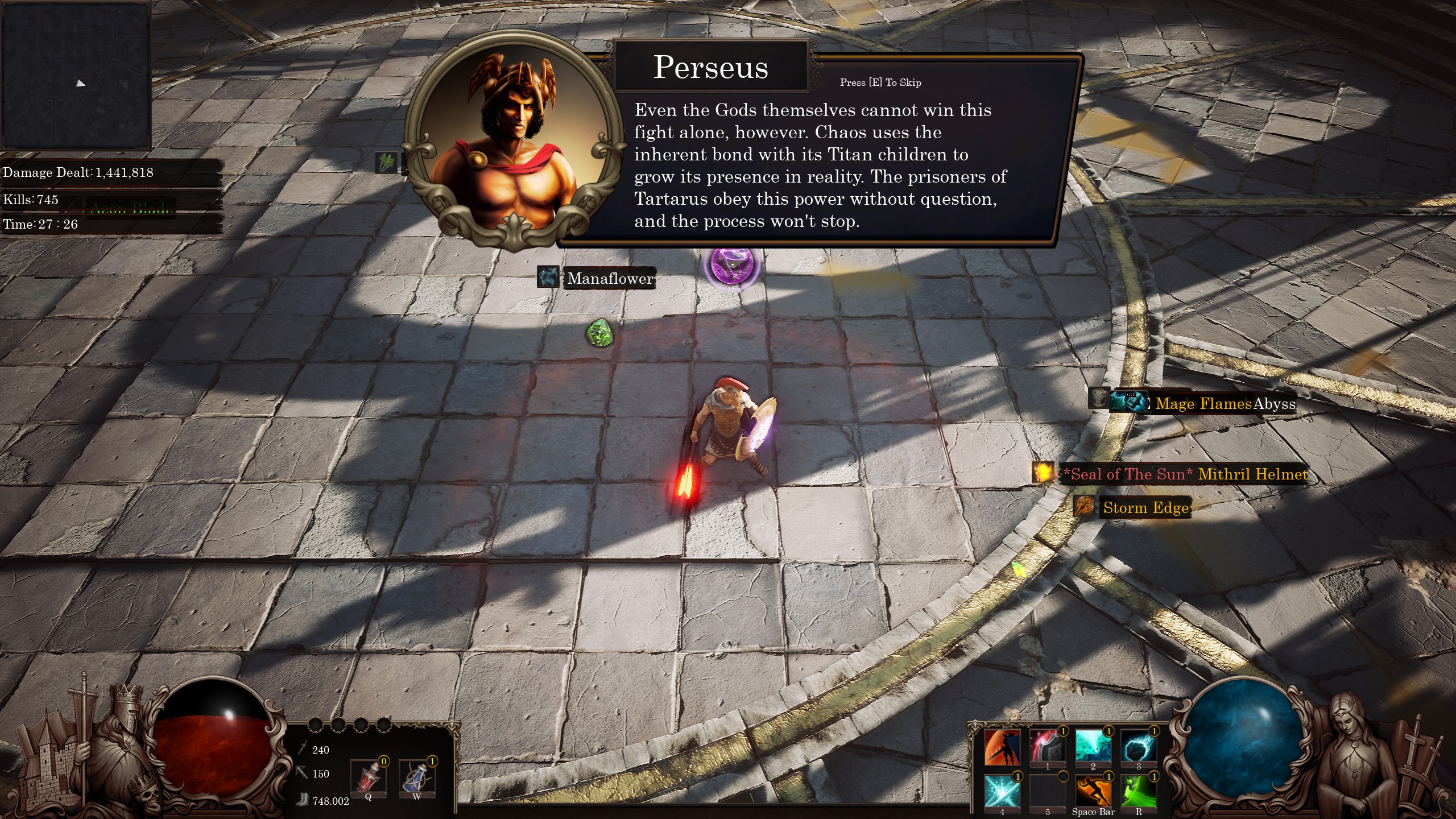Search
[{{{type}}}] {{{reason}}}
{{/data.error.root_cause}}{{{_source.title}}} {{#_source.showPrice}} {{{_source.displayPrice}}} {{/_source.showPrice}}
{{#_source.showLink}} {{/_source.showLink}} {{#_source.showDate}}{{{_source.displayDate}}}
{{/_source.showDate}}{{{_source.description}}}
{{#_source.additionalInfo}}{{#_source.additionalFields}} {{#title}} {{{label}}}: {{{title}}} {{/title}} {{/_source.additionalFields}}
{{/_source.additionalInfo}}- Details
- Category: Computer
- By Cinque Pierre
- Hits: 5406
Perseus Titan Slayer (PC)

Perseus Titan Slayer
Developed By: Sicarius
Published By: G-DEVS.com
Released: February 13, 2023
Available: Windows
Genre: Action Role-Playing; Roguelite
ESRB Rating: Not Rated
Number of Players: Single player
Price: $7.99
Thank You G-DEVS.com for providing us with a review code!
Back in late 2022, I had the privilege to preview a top-down 3D action roguelite called Perseus: Titan Slayer. I had fun with it and it showed promise with its fast-paced and simplistic combat, seemingly aiming for a more casual audience than hardcore. Multiple difficulties exist so that people who want more of a challenge can get just that. As I liked what the game showed in its preview, I would express interest in reviewing the full game once it comes out. Little did I know that Persues: Titan Slayer will receive such significant gameplay and mechanic changes that it is almost an entirely different game.
I guess I was the only person who liked what Perseus was before. The combat changes from a frantic “1 vs 100” frenzy to feel more like the top-down Diablo-like hack-and-slash dungeon crawler it is inspired by. Such a drastic change can only come from the result of either notable negative feedback or the developer not being satisfied with how things turned out. Combat is now much slower paced as outside of a few specific abilities, Perseus has to choose between attacking and movement. Enemies are now greatly reduced, with only about two dozen appearing on screen at one time at most to make up for this change. In exchange, they now do more damage on average.
Another drastic change is how the game controls. Movement in the previous beta/preview versions was done with the typical WASD controls or a gamepad. Now, movement is done by default with the left mouse button. But it isn’t like you click in a direction and the character moves as they would in a MOBA or RTS, but holding the mouse button down and moving the cursor in a direction to walk in said direction. Combined with that you now attack by holding the right mouse button and only partial controller support exists (when it wants to work), it feels weird. While you can remap the controls to other keys (and have the option to use traditional WASD movement), there still is a sense of awkwardness with how everything controls, You’ll probably run into some kind of issue no matter what. Sometimes, you have to restart your entire computer to get a gamepad to function.
There’s a juggling act between knowing when to attack and when to move around to maximize proficiently—at least in theory. Due to the overhaul in gameplay, there are some balance issues with the “classes” (as in weapon types) you can choose for Perseus. You have a sword & shield, a bow & arrow, dual daggers, and a “katana” to choose from. The latter looks more like a fusion between a cutlass and a scimitar instead of the iconic Japanese sword. Each has a unique passive and active ability to complement a specific playstyle. To summarize, the katana and daggers are far above the sword and bow because the former two mix offense and mobility with their abilities. It's to such a degree that you’re simply playing with a handicap if you choose the latter two. Outside of the final boss (which is to be expected), the experience is pretty easy at the start as the default difficulty is easygoing. Unfortunately, Perseus is one of those games where the difficulty is unlocked one by one so if you find it too easy, you have to slowly trudge through mindless encounters before a challenge presents itself.

Strong Points: Versatility in the weapons Perseus can choose for each playthrough
Weak Points: Limited enemy and stage variety; the interface and controls are awkward; lacks replay value
Moral Warnings: Violence with blood stains on the ground, bisecting bodies, and decapitating heads; setting is based heavily on Greek mythology; one splash art of Medusa in revealing clothing that may or may not exist (see moral section paragraph for full details)
The equipment system has also received an overhaul. As opposed to a MOBA-like system where you use gold to purchase equipment, it now drops from kills and treasure. The only thing gold is used for is to buy materials to enhance your equipment. Equipment is separated by categories such as chest and boots. The additional abilities to your attacks are now gems that are equipped to your armor. This is one change that is for the better as it now feels more like a roguelite and a hack-and-slash looter in which you have to make do with what you get instead of aiming for the best upgrade path every time.
At the beginning of each run, you have up to four paths to choose from that branch and intersect granting you various rewards if completed such as high-tier armor/weapons, extra lives, or additional skill points. You can also see ahead so you can plan your path to get specific rewards.
Levels are usually large open arenas. The third level, in particular, is a path containing many traps and pendulums meant to impede your progress. While there are some levels that contain some structures, they are so far spaced apart from the action that nearly every level feels the same. The enemy variety is also lacking as they'll either rush you in groups or stay back and hurl projectiles at you. The strategy for these enemies boils down to two methods: you corral them in a condensed circle and use all your abilities on them at once, or for the projectile enemies, you use your dodge whenever it is on cooldown and whittle away at their health. For a roguelite, runs start to blend in, and that becomes a detriment.
The survival mode has also received changes, going from a mostly automated experience where your abilities cast automatically, to more of a slightly different campaign. It plays just like the standard mode, but the only differences are that the whole thing takes place in one arena so there are no branching paths. I'm not sure why it exists as it isn't much different from the campaign.

Higher is better
(10/10 is perfect)
Game Score - 60%
Gameplay - 10/20
Graphics - 7/10
Sound - 6/10
Stability - 4/5
Controls - 3/5
Morality Score - 67%
Violence - 3.5/10
Language - 10/10
Sexual Content - 6.5/10
Occult/Supernatural - 3.5/10
Cultural/Moral/Ethical - 10/10
Perseus combines a semi-realistic look with some shading and lighting to give it a slight cel-like look. On the other hand, the environments are fairly basic and some are pretty bland. There is voice acting, and most of it is through simple dialogue that happens after every completed level. Another character that I believed is voiced is the shopkeeper where you buy and sell your enhancements. His voice can sound pretty whiny so I feel most people will get annoyed by him quickly. I believe that there is only one music track in the game and while it isn’t a bad one, it’s the only one I hear which is a disappointment.
The most notable things about Perseus in terms of morality are the violence and setting. Enemies shed plenty of blood when defeated and at times their bisected torsos or decapitated bodies can be seen on the ground. They eventually disappear when too many enemies are on screen. The entire setting is based on the Greek mythos and Perseus himself uses many magical items and weapons as part of his kit. You’ll come across gods such as Zeus, Hades, and Hermes. In my preview write-up, I mentioned that sometimes, the artwork can be pretty revealing as there is one piece of art in a cutscene that shows the Gorgon in little clothing, showcasing the side of her breast. But I’ve also run into a problem unique to my own. My PC entirely runs on SSDs, using M.2 NVMe and SATA. While this does come with the great benefit of loading being nearly instantaneous outside of starting up the game, this also has the unintended side effect of the levels loading before the splash art does. As I don’t own any HDDs, I do not have the option to see if any of the splash art has changed. Unless I find out otherwise, I am going to assume that any artwork that was in the preview still exists in the full game.
Perseus: Titan Slayer has good ideas but the execution isn’t the most well-done. For a roguelite, it doesn’t have much replay value after you defeat the final boss outside of some extra difficulties and accumulate shards to gain permanent upgrades for your weapon types. But outside of the final upgrade, the smaller upgrades don’t feel noticeable at all so it ends up feeling like one huge grind. I prefer roguelites where permanent stuff is unlocked through achievements or milestones as it encourages you to learn the ins and outs of a game instead of finding out the most efficient farming method. And then you start to ask the question of why it was made into a roguelite in the first place. I think that Perseus being a roguelite manages to hold it back and it would have been more beneficial to aim for a bite-sized hack-and-slash dungeon crawler.
I think this is the most disappointed and conflicted I felt about a product that I’ve reviewed ever because of the large changes made from preview to full release. Plus, ramming my head against the Chaos Dragon over and over again until I achieved victory may have tainted the whole experience. After you beat him once, there is little reason to come back as you've more or less seen everything. It's just achievements and upgrading your character, and even the achievements are tedious as beating bosses on a higher difficulty or with specific weapons doesn't count for difficulties below it. Even for the cheap price, the experience of Perseus: Titan Slayer doesn't hold enough interest to keep people coming back.








